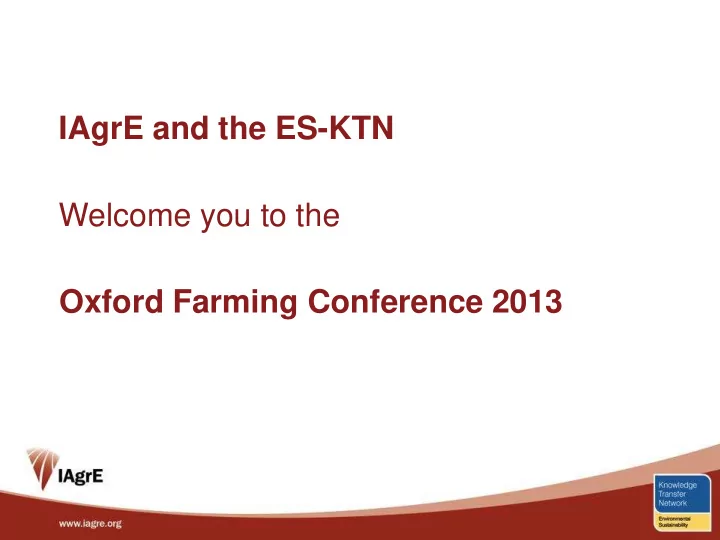

IAgrE and the ES-KTN Welcome you to the Oxford Farming Conference 2013
Agricultural Engineering offers solutions Mark Kibblewhite President-Elect, IAgrE Roger Lane-Nott CB Director General, AEA Anne Miller Sustainable Land Management and Soil Health Specialist, ESKTN
Global area of arable and permanent crops from 1961 to 2009 (thousands of hectares) (FAOSTAT) What is the problem? 1450000 • More people, getting richer, 1400000 1350000 with less agricultural land, 1300000 requires more food and 1250000 biofuel produced per hectare 1200000 with less emissions Cereals Price Index (FAO) • Global change, including 300.0 climate change e.g. weather 200.0 100.0 extremes, requires resilient 0.0 production systems Jan-90 11/1992 9/1995 7/1998 5/2001 3/2004 1/2007 11/2009
Three big challenges ahead • Water management using precision irrigation and intelligent field drainage • Energy management including on-farm energy production • Nutrient management to reduce inputs and reduce polluting emissions Intensive grazed pasture dairy system: • 945 litres of water per litre of raw milk* • 22ml diesel per litre of raw milk** • 476kJ indirect energy input as N fertiliser per litre of raw milk**, with ~ 55% N utilization * Zonderland-Thomassen & Ledgard (2012) ** Saunders and Barber (2007)
Agricultural Engineering • Integrates and transforms science to tools and processes that improve the productivity and Recycling nitrogen Teagasc environmental performance of agriculture and other land- based industries • Drives the mechanisation, informatics and land engineering needed to secure global food production while limiting the environmental impacts of intensification. Engineering microclimates
How can Agricultural Engineering contribute more? • Producer focused development, driven by problems (strategic as More investment is needed in developers well as operational) • Focus more public and private investment on the application of scientific research to agriculture and on the transformation of technology developed in other sectors • Educate, train and develop agricultural engineers. Kibblewhite, Deeks and Clarke (2010)
Immediate steps? • Work together on industry- Plants Plants Management Management Fertiliser Fertiliser led or partnered proposals to Harvest Harvest Plant residue Plant residue the research funders (e.g. Climate Climate Climate Climate Mineral pool Mineral pool Resource quality Resource quality Soil conditions Soil conditions TSB, BBSRC, EC) to turn Fungi Fungi Bacteria Bacteria Active Active organic pool organic pool Loss Loss science in to useful tools Fungivorous Fungivorous Fungivorous Fungivorous Bacterivorous Bacterivorous Protozoa Protozoa Slow-passive Slow-passive microarthropods microarthropods nematodes nematodes nematodes nematodes organic pool organic pool • Develop relationships with Earthworms Earthworms Enchytraeids Enchytraeids Microarthropods Microarthropods Macroarthropods Macroarthropods ICT professionals in other Kibblewhite, Ritz & Swift (2008) sectors and pull their How can engineering exploit new innovation in to agriculture knowledge about soil biology to • Support students and early- increase agricultural productivity? career professionals in the UK and internationally.
Priorities for Farm Machinery • More publicly funded non-competitive strategic research into innovative machinery • More emphasis on smaller machines (ATVs) and towed implements for the smaller field sizes in Africa and elsewhere • Better explanation of the benefits to animal health of robotic milking machines • Research to sustainably wean farming off fossil fuels • Improved machinery for sustainable irrigation
Strategic requirement • More understanding and recognition by Government and others of the role of Agricultural Engineering.
Environmental Sustainability KTN mission: Accelerating the transition to a low carbon, resource and energy efficient economy by connecting businesses, universities, other research organisations & Government agencies Catalysing innovation across emerging environmental technologies
ESKTN Key Priority Areas Our Priority Areas have been identified as those offering the greatest potential for businesses to develop innovative and environmentally sustainable products and services.
Connecting for Innovation Roadmaps & Publications Technical Advisory Group Knowledge Exchange Spotting Opportunities Case Studentships Investment Sources Policy Advice Partner Search Promoting KTP Universities and other R&D Industry
Overview and R&D strategic reports
Recommend
More recommend